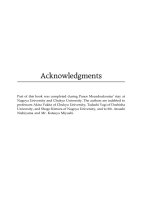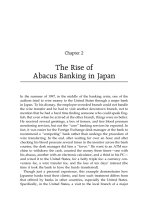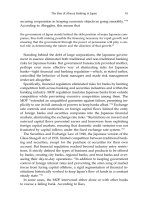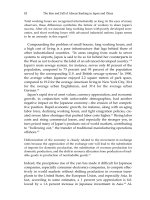Toby a h wilkinson the rise and fall of ancient egypt (v5 0)
Bạn đang xem bản rút gọn của tài liệu. Xem và tải ngay bản đầy đủ của tài liệu tại đây (13.5 MB, 525 trang )
ALSO BY TOBY WILKINSON
Early Dynastic Egypt
Royal Annals of Ancient Egypt
Genesis of the Pharaohs
The Thames & Hudson Dictionary of Ancient Egypt
Lives of the Ancient Egyptians
The Egyptian World (editor)
Copyright © 2010 by Toby Wilkinson
All rights reserved.
Published in the United States by Random House, an imprint of The Random House Publishing Group, a division of Random House, Inc., New York.
RANDOM HOUSE and colophon are registered trademarks of Random House, Inc.
Originally published in the United Kingdom by Bloomsbury Publishing, Plc., London, in 2010.
All images reproduced in the insert sections are courtesy of the Werner Forman Archive, with the exception of the pectoral of Princess M ereret, which is reproduced
courtesy of Sandro Vannini/Corbis.
LIBRARY OF CONGRESS CATALOGING-IN-PUBLICATION DATA
Wilkinson, Toby A. H.
The rise and fall of ancient Egypt / Toby Wilkinson.
p. cm.
Includes bibliographical references.
eISBN: 978-0-679-60429-7
1. Egypt—History—To 332 B.C. 2. Egypt—History—332–30 B.C. I. Title.
DT83.W658 2011 932—dc22 2009047322
www.atrandom.com
Maps by John Gilkes
v3.1
FOR BEN AND GINNY
“M y name is Ozymandias, king of kings:
Look on my works, ye M ighty, and despair!”
Nothing beside remains. Round the decay
Of that colossal wreck, boundless and bare,
The lone and level sands stretch far away.
—PERCY BYSSHE SHELLEY, “Ozymandias”
CONTENTS
Cover
Other Books by This Author
Title Page
Copyright
Dedication
Timeline
Author’s Note
Introduction
DIVINE RIGHT (5000–2175 B.C.)
1. IN THE BEGINNING
2. GOD INCARNATE
3. ABSOLUTE POWER
4. HEAVEN ON EARTH
5. ETERNITY ASSURED
PART I:
END OF INNOCENCE (2175–1541 B.C.)
6. CIVIL WAR
7. PARADISE POSTPONED
8. THE FACE OF TYRANNY
9. BITTER HARVEST
PART II:
THE POWER AND THE GLORY (1541–1322 B.C.)
10. ORDER REIM POSED
11. PUSHING THE BOUNDARIES
12. KING AND COUNTRY
13. GOLDEN AGE
14. ROYAL REVOLUTION
PART III:
MILITARY MIGHT (1322–1069 B.C.)
15. MARTIAL LAW
16. WAR AND PEACE
PART IV:
17. TRIUM PH AND TRAGEDY
18. DOUBLE-EDGED SWORD
CHANGE AND DECAY (1069–30 B.C.)
19. A HOUSE DIVIDED
20. A TARNISHED THRONE
21. FORTUNE’S FICKLE WHEEL
22. INVASION AND INTROSPECTION
23. THE LONG GOODBYE
24. FINIS
PART V:
Epilogue
Acknowledgments
Photo Insert
Notes
Bibliography
About the Author
TIMELINE
All dates are B.C. The margin of error is within a century or so circa 3000 B.C. and within two decades
circa 1300 B.C.; dates are precise from 664 B.C. The system of dynasties devised in the third century B.C.
is not without its problems—for example, the Seventh Dynasty is now recognized as being wholly
spurious, while several dynasties are known to have ruled concurrently in different parts of Egypt—
but this system remains the most convenient method for subdividing ancient Egyptian history. The
broader periods are more modern scholarly conventions.
EARLY DYNASTIC PERIOD, 2950–2575
OLD KINGDOM, 2575–2125
FIRST INTERMEDIATE PERIOD, 2125–2010
MIDDLE KINGDOM, 2010–1630
SECOND INTERMEDIATE PERIOD, 1630–1539
NEW KINGDOM, 1539–1069
THIRD INTERMEDIATE PERIOD, 1069–664
LATE PERIOD, 664–332
MACEDONIAN DYNASTY, 332–309
PTOLEMAIC PERIOD, 309–30
AUTHOR’S NOTE
PROPER NAMES
Names of ancient Egyptian people and places have been given in the form most closely approximating
the original usage (where this is known), except when the classical form of a place-name has given
rise to a widely used adjective. Therefore, “Memphis” (and “Memphite”) are used instead of “Mennefer” or the earlier “Ineb-hedj,” “Thebes” (“Theban”) rather than “Waset,” “Sais” (“Saite”) instead
of “Sa,” and “Herakleopolis” (“Herakleopolitan”) instead of “Nen-nesut.” For ease of reference, the
modern equivalent is given in parenthesis after the first mention of an ancient place-name in the text,
and the ancient equivalents are given for classical toponyms.
For reasons of accessibility, the names of the Persian and Greek rulers of Egypt in the sixth to first
centuries B.C. have been given in their classical and anglicized forms, respectively: for example,
Darius instead of Dariyahavush, Ptolemy rather than Ptolemaios, Mark Antony instead of Marcus
Antonius.
The Roman numerals (e.g., Thutmose I–IV, Ptolemy I–XV) are a modern convention, used to
distinguish between different kings in a sequence who shared the same birth name. Throughout most
of Egyptian history, the kings were referred to principally by their throne names; these are formulaic,
often long-winded, and generally unfamiliar except to Egyptologists.
DATES
All dates are B.C., except in the Introduction and Epilogue or unless explicitly stated. For dates before
664 B.C., there is a margin of error that ranges from ten to twenty years for the New Kingdom to as
much as fifty to a hundred years for the Early Dynastic Period; the dates given in the text represent the
latest scholarly consensus. From 664 B.C. onward, sources external to Egypt make a precise
chronology possible.
INTRODUCTION
TWO HOURS BEFORE SUNSET ON NOVEM BER 26, 1922, THE ENGLISH Egyptologist Howard Carter and three
companions entered a rock-cut corridor dug into the floor of the Valley of the Kings. The three
middle-aged men and one much younger woman made an unlikely foursome. Carter was a neat, rather
stiff man in his late forties, with a carefully clipped mustache and slicked-back hair. He had a
reputation in archaeological circles for obstinacy and a temper, but was also respected, if somewhat
grudgingly, for his serious and scholarly approach to excavating. He had made Egyptology his career
but, lacking private means, was dependent on others to fund his work. Fortunately, he had found just
the right man to bankroll his current excavations on the west bank of the Nile at Luxor. Indeed, his
patron was now beside him to share in the excitement of the moment.
George Herbert, fifth earl of Carnarvon, cut a very different figure. Raffish and debonair, even for
his fifty-six years, he had led the life of an aristocratic dilettante, as a young man indulging his love of
fast cars. But a driving accident in 1901 had nearly cost him his life; it had left him weakened and
prone to rheumatic pain. To spare himself the cold, damp air of English winters, he had taken to
spending several months each year in the warmer, drier climate of Egypt. So had begun his own,
amateur interest in archaeology. A meeting with Carter in 1907 inaugurated the partnership that was
to make history. Joining the two men on this “day of days”—as Carter was later to describe it—were
Carnarvon’s daughter, Lady Evelyn Herbert, and Carter’s old friend Arthur “Pecky” Callender, a
retired railway manager who had joined the excavation only three weeks earlier. Although a novice
to archaeology, Callender had a knowledge of architecture and engineering that made him a useful
member of the team. His carefulness and dependability appealed to Carter, and he was well used to
Carter’s frequent mood swings.
Howard Carter and the governor of Qena province greet Lady Evelyn Herbert and Lord Carnarvon on their arrival at Luxor station, November 23, 1922. SOURCE
UNKNOWN
Just three days into the excavation season (which was due to be the last season—even Carnarvon’s
fortune was not inexhaustible), workmen had uncovered a flight of steps leading downward into the
bedrock. Once the staircase had been fully cleared, an outer blocking wall had been revealed,
covered with plaster and stamped with seal impressions. Even without deciphering the inscription,
Carter had known what this meant: he had found an intact tomb from the period of ancient Egyptian
history known as the New Kingdom, an era of great pharaohs and beautiful queens. Was it possible
that beyond the blocking wall lay the prize for which Carter had been striving for seven long years?
Was it the last undiscovered tomb in the Valley of the Kings? Always a stickler for correctness,
Carter had put decorum first and ordered his workmen to refill the flight of steps, pending the arrival
from England of the expedition’s sponsor, Lord Carnarvon. If there was a major discovery to be
made, it was only proper that patron and archaeologist should share it together. So on November 6,
Carter sent a telegram to Carnarvon: “At last have made wonderful discovery in Valley; a magnificent
tomb with seals intact; re-covered same for your arrival; congratulations.”
After a seventeen-day journey by ship and train, the earl and Lady Evelyn arrived in Luxor, to be
met by an impatient and excited Carter. The very next morning, work to clear the steps began in
earnest. On November 26, the outer blocking wall was removed to reveal a corridor, filled with
stone chips. From the pattern of disturbance running through the fill, it was clear that someone had
been there before: robbers must have entered the tomb in antiquity. But the seal impressions on the
outer blocking wall showed that it had been resealed in the New Kingdom. What might this mean for
the state of the burial itself? There was always the possibility that it would turn out in the end to be a
private tomb, or a cache of funerary equipment collected from earlier robbed tombs in the Valley of
the Kings and reburied for safety. After a further day of strenuous work, in the heat and dust of the
valley floor, the corridor was emptied. Now, after what must have felt like an interminable wait, the
way ahead was clear. Carter, Carnarvon, Callender, and Lady Evelyn found themselves before yet
another blocking wall, its surface also covered with large oval seal impressions. A slightly darker
patch of plaster in the top left-hand corner of the wall showed where the ancient robbers had broken
in. What would greet this next set of visitors, more than three and a half thousand years later?
Without further hesitation, Carter took his trowel and made a small hole in the plaster blocking, just
big enough to look through. First, as a safety precaution, he took a lighted candle and put it through the
hole, to test for asphyxiating gases. Then, with his face pressed against the plaster wall, he peered
through into the darkness. The hot air escaping from the sealed chamber caused the candle to flicker,
and it took a few moments for Carter’s eyes to grow accustomed to the gloom. But then details of the
room beyond began to emerge. Carter stood dumbstruck. After some minutes, Carnarvon could bear
the suspense no longer. “Can you see anything?” he asked. “Yes, yes,” replied Carter, “wonderful
things.” The following day, Carter wrote excitedly to his friend and fellow Egyptologist Alan
Gardiner, “I imagine it is the greatest find ever made.”
Carter and Carnarvon had discovered an intact royal tomb from the golden age of ancient Egypt. It
was crammed, in Carter’s own words, with “enough stuff to fill the whole upstairs Egyptian section
of the B[ritish] M[useum].” The antechamber alone—the first of four rooms entered by Carter and his
associates—contained treasures of unimaginable opulence: three colossal gilded ceremonial beds, in
the shapes of fabulous creatures; golden shrines with images of gods and goddesses; painted jewelry
boxes and inlaid caskets; gilded chariots and fine archery equipment; a magnificent gold throne, inlaid
with silver and precious stones; vases of beautiful translucent alabaster; and, guarding the right-hand
wall, two life-size figures of the dead king, with black skin and gold accoutrements. The royal name
on many of the objects left no doubt as to the identity of the tomb owner: the hieroglyphs clearly
spelled out Tut-ankh-Amun.
By curious concidence, the breakthrough that had allowed ancient Egyptian writing to be first
deciphered, and had thus opened up the study of pharaonic civilization through its numerous
inscriptions, had occurred exactly a century before. In 1822, the French scholar Jean-François
Champollion published his famous Lettre à M. Dacier, in which he correctly described the workings
of the hieroglyphic writing system and identified the phonetic values of many important signs. This
turning point in the history of Egyptology was itself the result of a long period of study.
Champollion’s interest in ancient Egyptian writing had been prompted when he’d first learned about
the Rosetta Stone as a boy. A royal proclamation inscribed in three scripts (Greek, demotic
characters, and hieroglyphics), the stone had been discovered by Napoleonic troops at el-Rashid
(Rosetta) during the French invasion of 1798, when Champollion was eight years old, and it was to
provide one of the main keys to the decipherment of Egyptian hieroglyphics. Champollion’s early
genius for languages had enabled him to become proficient in Greek and, crucial in this endeavor,
Coptic, the liturgical language of the Egyptian Orthodox Church and a direct descendant of ancient
Egyptian. Armed with this knowledge, and with a transcription of the Rosetta Stone, Champollion
correctly translated the hieroglyphic version of the text and so began the process that was to unlock
the secrets of ancient Egyptian history. His grammar and dictionary of the ancient Egyptian language,
published posthumously, allowed scholars, for the first time, to read the words of the pharaohs
themselves, after an interval of more than two thousand years.
At the same time that Champollion was working on the mysteries of the ancient Egyptian language,
an Englishman, John Gardner Wilkinson, was making an equally important contribution to the study of
pharaonic civilization. Born a year before Napoléon’s invasion, Wilkinson traveled to Egypt at the
age of twenty-four and stayed for the next twelve years, visiting virtually every known site, copying
countless tomb scenes and inscriptions, and carrying out the most comprehensive study of pharaonic
monuments undertaken to that point. (For a year, in 1828–1829, Wilkinson and Champollion were
both in Egypt, traveling and recording, but it is not known if the two ever met.) On his return to
England in 1833, Wilkinson began compiling the results of his work and published them four years
later. The three-volume Manners and Customs of the Ancient Egyptians, together with the twovolume Modern Egypt and Thebes (published in 1843), was and remains the greatest review of
ancient Egyptian civilization ever accomplished.
Wilkinson became the most famous and most honored Egyptologist of his age, and is regarded, with
Champollion, as one of the founders of the subject. Just a year before Wilkinson died, Howard Carter
was born, the man who was to take Egyptology—and the public fascination with ancient Egypt—to
new heights. Unlike his two great forebears, Carter stumbled into Egyptology almost by accident. It
was his skill as a draftsman and painter, rather than any deep-rooted fascination with ancient Egypt,
that secured him his first position on the staff of the Archaeological Survey at the age of seventeen.
This brought Carter the opportunity to train under some of the greatest archaeologists of the day—
including Flinders Petrie, the father of Egyptian archaeology, with whom he excavated at Amarna, the
capital city of the heretic pharaoh Akhenaten and the probable birthplace of Tutankhamun. By copying
tomb and temple scenes for various expeditions, Carter became intimately acquainted with ancient
Egyptian art. His firsthand knowledge of many of the major archaeological sites would, no doubt,
have been supplemented by reading the works of Wilkinson. So it was that, in 1899, Carter came to
be appointed inspector general of monuments of Upper Egypt, and four years later of Lower Egypt.
But his hot temper and stubbornness brought his promising career to an abrupt end when he refused to
apologize after an altercation with some French tourists, and he was promptly sacked from the
Antiquities Service (then under French control). Returning to his roots, Carter earned his living for
the next four years as an itinerant watercolorist, before joining forces with Lord Carnarvon in 1907 to
begin excavating, once again, at Thebes.
After fifteen long, hot, and none-too-fruitful years, Carter and his sponsor finally made the greatest
discovery in the history of Egyptology.
After sunset that November day in 1922, the astonished party made its way back to Carter’s house for
a fitful night’s sleep. It was impossible to take in everything that had happened. They had made the
greatest archaeological discovery the world had ever seen. Nothing would be the same again. But one
final question nagged at Carter. He had found Tutankhamun’s tomb, and the bouquets of flowers left
over from the royal funeral, but did the king himself still lie, undisturbed, in his burial chamber?
The new dawn brought with it a feverish rush of activity, as Carter began to appreciate the
immensity of the task that lay before him. He realized he would need to assemble—and quickly—a
team of experts to help photograph, catalogue, and conserve the vast number of objects in the tomb.
He started contacting friends and colleagues, and informed the Egyptian antiquities authorities about
the spectacular discovery. A date of November 29 was agreed upon for the official public opening of
the tomb. The event would be covered by the world’s press, the first major archaeological discovery
of the media age. Thereafter, it would be impossible for Carter to retain control of the situation. If he
wanted to solve the mystery of the king’s final resting place, quietly, and in his own time, he would
have to do so before the official opening, and go behind the backs of the antiquities officials.
On the evening of November 28, a matter of hours before the press were due to arrive, Carter and
his three trusted companions slipped away from the crowds and entered the tomb once more. His
instinct told him that the black-skinned guardian figures framing the right-hand wall of the
antechamber had to indicate the location of the burial chamber. The plaster wall behind them
confirmed as much. Once again Carter made a small hole in the plaster wall, at ground level, just big
enough to squeeze through, and with an electric flashlight this time instead of a candle, he crawled
through the opening. Carnarvon and Lady Evelyn followed; Callender, being a little too portly, stayed
behind. The three inside found themselves face-to-face with an enormous gilded shrine that filled the
room. Opening its doors revealed a second shrine nested within the first … then a third, and a fourth
shrine concealing the stone sarcophagus. Now Carter knew for certain: the king’s burial lay within,
having been undisturbed for thirty-three centuries. After squeezing back out into the antechamber,
Carter hastily, and rather clumsily, disguised his unauthorized break-in with a basket and a bundle of
reeds. For another three months, no one else would see what Carter, Carnarvon, and Lady Evelyn had
seen.
The public unveiling of Tutankhamun’s tomb made newspaper headlines around the world on
November 30, 1922, capturing the public’s imagination and generating a wave of popular interest in
the treasures of the pharaohs. But there was more to come. The official opening of the burial chamber
on February 16, 1923, was followed a year later by the lifting of the one-and-a-quarter-ton lid from
the king’s immense stone sarcophagus—a feat expertly accomplished by Callender with his
engineering background. Inside the sarcophagus, there were yet more layers protecting the pharaoh’s
body: three nested coffins, to complement the four gilded shrines. The two outer coffins were of
gilded wood, but the third, innermost coffin was of solid gold. Inside each coffin there were amulets
and ritual objects, all of which had to be carefully documented and removed before the next layer
could be examined. The whole process, from lifting the lid of the sarcophagus to opening the third
coffin, took more than eighteen months. Finally, on October 28, 1925, nearly three years after the
discovery of the tomb and two years after Carnarvon’s untimely death (not from the pharaoh’s curse
but from blood poisoning), the moment was at hand to reveal the boy king’s mummified remains.
Using an elaborate system of pulleys, the lid of the innermost coffin was raised by its original
handles. Inside lay the royal mummy, caked in embalming unguents that had blackened with age.
Standing out from this tarry mess, and covering the king’s face, was a magnificent funerary mask of
beaten gold in the image of the young monarch. Above his brow were the vulture and cobra
goddesses, and around his neck was a broad collar of inlaid glass and semiprecious stones. Carter
and Tutankhamun had come face-to-face at last.
Howard Carter cleaning Tutankhamun’s second coffin.
© GRIFFITH INSTITUTE, UNIVERSITY OF OXFORD
The mask of Tutankhamun is perhaps the most splendid artifact ever recovered from an ancient
civilization. It dazzles us today as it did those who first beheld it in modern times, almost a century
ago. During the 1960s and ’70s, it formed the highlight of the traveling Tutankhamun exhibition,
drawing crowds of millions around the world, from Vancouver to Tokyo. Although I was too young to
visit the show when it came to London, the book published to accompany the exhibition was my first
introduction to the exotic world of ancient Egypt. I remember reading the book on the landing at home,
at age six, marveling at the jewels, the gold, the strange names of kings and gods. The treasures of
Tutankhamun planted a seed in my mind that was to grow and flourish in later years. But the ground
had already been prepared. A year earlier, at the age of five, while leafing through the pages of my
first childhood encyclopedia, I had noticed an entry illustrating different writing systems. Never mind
the Greek, Arabic, Indian, and Chinese scripts: it was the Egyptian hieroglyphics that captured my
imagination. The book gave only a few signs, but they were enough to allow me to work out how to
write my own name. Hieroglyphs and Tutankhamun set me on the path to becoming an Egyptologist.
Indeed, writing and kingship were the twin cornerstones of pharaonic civilization, the defining
characteristics that set it apart from other ancient cultures. Despite the efforts of archaeologists to
uncover the rubbish dumps and workshops that would reveal the daily lives of ordinary citizens, it is
the abundant written record and the imposing edifices left behind by the pharaohs that continue to
dominate our view of ancient Egyptian history. In the face of such powerful testimonies, perhaps it is
not surprising that we are inclined to take the texts and monuments at face value. And yet the dazzling
treasures of the pharaohs should not blind us to a more complex truth. Despite its spectacular
monuments, magnificent works of art, and lasting cultural achievements, ancient Egypt had a darker
side.
The first pharaohs understood the extraordinary power of ideology—and of its visual counterpart,
iconography—to unite a disparate people and bind them in loyalty to the state. Egypt’s earliest kings
formulated and harnessed the tools of leadership that are still with us: elaborate trappings of office
and carefully choreographed public appearances to set the ruler apart from the populace; pomp and
spectacle on grand state occasions to reinforce bonds of loyalty; patriotic fervor expressed orally and
visually. But the pharaohs and their advisers knew equally well that their grip on power could be
maintained just as effectively by other, less benign means: political propaganda, an ideology of
xenophobia, close surveillance of the population, and brutal repression of dissent.
In studying ancient Egypt for more than twenty years, I have grown increasingly uneasy about the
subject of my research. Scholars and enthusiasts alike are inclined to look at pharaonic culture with
misty-eyed reverence. We marvel at the pyramids, without stopping to think too much about the
political system that made them possible. We take vicarious pleasure in the pharaohs’ military
victories—Thutmose III at the Battle of Megiddo, Ramesses II at the Battle of Kadesh—without
pausing too long to reflect on the brutality of warfare in the ancient world. We thrill at the weirdness
of the heretic king Akhenaten and all his works, but do not question what it is like to live under a
despotic, fanatical ruler (despite the modern parallels, such as in North Korea, that fill our television
screens). Evidence for the darker side of pharaonic civilization is not lacking. From human sacrifice
in the First Dynasty to a peasants’ revolt under the Ptolemies, ancient Egypt was a society in which
the relationship between the king and his subjects was based on coercion and fear, not love and
admiration—where royal power was absolute, and life was cheap. The aim of this book is to give a
fuller and more balanced picture of ancient Egyptian civilization than is often found in the pages of
scholarly or popular works. I have set out to reveal both the highs and the lows, the successes and the
failures, the boldness and the brutality that characterized life under the pharaohs.
The history of the Nile Valley lays bare the relationship between rulers and the ruled—a
relationship that has proved stubbornly immutable across centuries and cultures. The ancient
Egyptians invented the concept of the nation-state that still dominates our planet, five thousand years
later. The Egyptians’ creation was remarkable, not only for its impact, but also for its longevity: the
pharaonic state, as originally conceived, lasted for three millennia. (By comparison, Rome barely
managed one millennium, while Western culture has yet to survive two.) A key reason for this
remarkable survival is that the philosophical and political framework first developed at the birth of
ancient Egypt was so well attuned to the national psyche that it remained the archetypal pattern of
government for the next one hundred generations. Despite prolonged periods of political
fragmentation, decentralization, and unrest, pharaonic rule remained a powerful ideal. A political
creed that harnesses itself to a national myth can embed itself very deeply in the human
consciousness.
It is extremely difficult to engage with a culture so remote in time and place from our own. Ancient
Egypt was a sparsely populated tribal society. Its polytheistic religion, its premonetary economy, the
low rate of literacy, and the ideological dominance of divine kingship—all these defining
characteristics are utterly alien to contemporary Western observers, myself included. As well as a
familiarity with two centuries of scholarship, the study of ancient Egypt thus requires a huge leap of
imagination. And yet, our common humanity offers a way in. In the careers of ancient Egypt’s rulers,
we see the motives that drive ambitious men and women revealed in the pages of history for the very
first time. The study of ancient Egyptian civilization likewise exposes the devices by which people
have been organized, cajoled, dominated, and subjugated down to the present day. And with the
benefit of hindsight, we can see in the self-confidence of pharaonic culture the seeds of its own
destruction.
The rise and fall of ancient Egypt holds lessons for us all.









